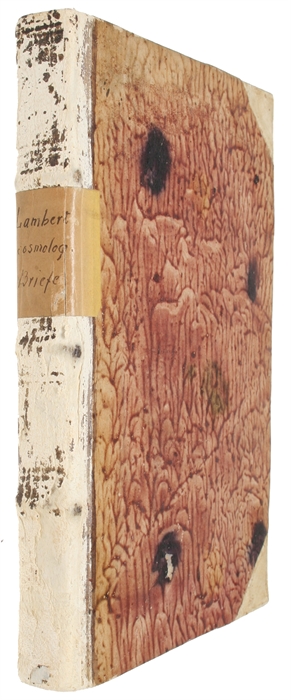PRE-ESTABLISHING THE BASIC FEATURES OF THE UNIVERSE
LAMBERT, J.H.
Cosmologische Briefe über die Einrichtung des Weltbaues.
Augspurg, Eberhard Kletts Wittib., 1761.
Contemporary white-dyed sheepskin. Spine with a bit of surface wear, old hand-written paper-label to spine. XXVIII, 317 pp. A stamp inside front free end-paper. Light browning, scattered marginal brownspots, but in general a fine copy. A few leaves in "Vorrede" misbound.
The scarce first edition of Lambert's sensational "Cosmological Letters", his most important astronomical work, in which he to a large extent fore-shadowed the documentation of the basic features of the universe that Hershel later carried out.
The work became very popular and was translated into French, Russian, and English, and it was later re-written and published as "Systeme du Monde" in Berlin, 1770.
"Of special interest among Lambert's astronomical writings - apart from applications of his physical doctrines - are his famous Cosmologische Briefe über die Einrichtung des Weltbaues" (Augsburg, 1761).Not familiar with the similar ideas of Thomas Wright (1750) and with Kant's "Allgemeine Naturgeschichte und Theorie des Himmels" (1755), Lambert had the idea that what appears as the Milky Way might be the visual effect of a lens-shaped universe. On this basis he elaborated a theory according to which the thousand of stars surrounding the sun constituted a system. Moreover he considered the Milky Way as a large number of such systems, that is, a system of higher order…; the "Cosmologische Briefe was a great sensation and was translated into French, Russian, and English. Only when William Hershel systematically examined the heavens telescopically and discovered numerous nebulae and "telescopic milky-ways" did it become obvious that Lambert's description was not mere science fiction but to a large extent a bold vision of the basic features of the universe" (Scriba in D.S.B. VII:598).
Kant's mentor (Martin Knutzen) died in 1755, three years before the pre-critical project unfolded. But Kant still had the chance of meeting kindred spirits. One of these was the great philosopher and mathematician Johann Heinrich Lambert, whom he admired a great deal. Finally he had encountered a thinker who appreciated both the scientific and metaphysical perspective, who worried about their tensions, and who was searching for a truce. In his "Cosmologische Briefe…" (Cosmological Letters on the establishment of the universe), Lambert worked on the same topic as Kant had worked on in his earlier Universal Natural History. The tasks and results of both works resemble each other, in so far as they were both proposals of integrating Newtonian physics into a larger framework, and they both contained a theory of the dynamic constitution of the universe. Furthermore, as Kant's scientific works should be viewed under the perspective of his general philosophical outlook, so must Lambert's work in physics and astronomy be seen in relation to his general philosophical outlook and his perpetual quest for introducing mathematical exactness into the sciences. "Lambert's efforts to improve communication and collaboration in astronomy were noteworthy. He promoted the publication of astronomical journals and founded "Berliner astronomisches Jahrbuch oder Ephemeriden". Many of the articles that he contributed to it were not published until after his death... He also favored the founding of the Berlin observatory. These suggestions, in line with Leibniz' far-reaching plans for international cooperation of scientific societies, inaugurated a new period of scientific teamwork." (D.S.B., VII:598).
Order-nr.: 38885



